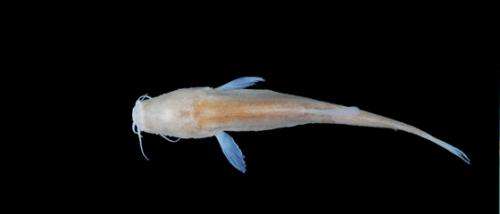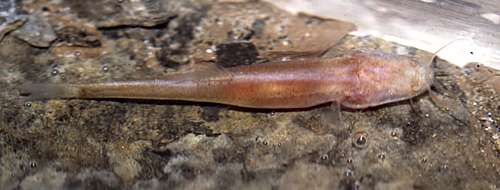Blind, scaleless cave fish species discovered in Vietnam

Could there be more biological treasures awaiting discovery in Asia's limestone cave systems?
Ha Long Bay in the Gulf of Tonkin, Vietnam, was inscribed as a World Heritage Site in 1995 and provides a spectacular seascape of some 2,000 islets and other islands. The Bay is famous for its geology and scenery, especially its towering limestone pillars, magnificent arches and its vast and beautiful caves. As a result, it is visited by hundreds of thousands of tourists annually.
The largest area of coastal limestone towers in the world, Ha Long Bay's natural beauty is complemented by its great biological diversity. Probably few visitors are aware that Ha Long Bay is home to 14 endemic plants and 60 endemic animals. Even fewer will be aware of the fascinating and unique creatures that exist there, confined to a system of subterranean caves.
In 2002, at the request of the Site's Management Authority, Fauna & Flora International (FFI) began an extensive survey of Ha Long Bay's biodiversity. Experts in karst limestone ecology from Slovenia joined local experts in 2003, and it was during these surveys that the new loach was discovered by University of Ljubljana biologists Boris Sket and Peter Trontelj on the tiny (1 km2) and contorted Van Gio Island. The fish has just been described in Revue suisse de Zoologie by the world-renowned Swiss ichthyologist, Maurice Kottelat, not just as a new species but as a new genus to be known as Draconectes narinosus.

This inch-long fish is notable for having no eyes, no markings and no scales – all common adaptations for animals that have evolved in the total darkness of deep limestone caves.
Its relatives most typically inhabit fast-flowing rivers where they live under stones and rocks. A number of loaches are already known from caves in the region and more await description.
The name of this new fish derives from the Greek for dragon (drakon) and swimmer (nectes) – a reference to Ha Long which means 'descending dragon' (so-called because, according to local legend, the landscape was created by a dragon). The Latin 'narinosus' means 'who has large nostrils'.
Also found in the cave was a new species of amphipod crustacean, Seborgia vietnamica, which is likely to be a major component of this fish's diet.
The fish belongs to a family which is strictly limited to freshwater and so cannot cross seawater. This means that it is very likely to be endemic to Van Gio Island. Scientists are yet to discover whether there are other related species on nearby islands, or whether this is the only surviving species in its genus.

It is remarkable that this species has managed to evolve and survive on such a small island. The new fish appears to be restricted to the island, which has long, narrow arms with a maximum width of just 400 metres. The cave's freshwater lake (where the fish was found) is barely 200 metres from the sea and at about sea level. It is thus extremely sensitive to rainfall and climate change, as well as human activities.
FFI is a leading NGO for the conservation of limestone karst and cave conservation, and has run a variety of projects in karst landscapes throughout the Asia-Pacific region. FFI now also works with cement companies to help their quarry management take full account of the biodiversity values in areas where they operate, particularly the 'hidden' cave animals such as this fish and the remarkable, highly adapted invertebrates found in these environments.
More information: Kottelat, M. 2012. Draconectes narinosus, a new genus and species of cave fish from an island of Halong Bay, Vietnam (Teleostei: Nemacheilidae). Revue suisse de Zoologie 119 (3): 341-349).
Provided by Fauna & Flora International


















